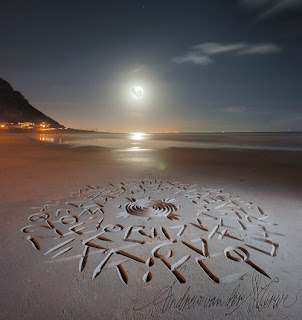http://www.africandigitalart.com/category/featured-projects/typography-featured-projects/
African beach calligraphy
I have found a great example of African inspired graphic design. Andrew van der Merwe is a typographer who writes his calligraphy into sand.
South African calligrapher, Andrew van der Merwe, has taken writing in the sand to the ultimate next level. A professional calligrapher and typographer, Andrew has developed his own technique of carving letters in the sand. Most of the forms he designs are inspired from African writing systems. Utilizing digital photography, Andrew shoots his masterful typefaces on beaches throughout Africa.
'Sun, water, sand and wind are strong themes in my work. I particularly enjoy playing with African and other ancient writing systems in an asemic way.'
These are beautiful examples of typography, and I love the idea of using African writing systems to influence today's typography and calligraphy. A touch of traditional African culture used in modern art and design.
Afrobeat font
A modern font African font inspired by the tribal rhythms of Afrobeat music. Although to me, aesthetically it doesn't immediately show traditional African styles, I can see how it has been influenced by the upbeat music, the typeface itself looks lively as if dancing to music.
The pounding tribal rhythms of Afrobeat music is expressed through this psychedelic brand new font, Afrobeat. Every letter becomes art as every letter is elegantly placed side by side, like music notes, creating music for the eyes.
Afrobeat is a musical style performed by many African artists such as Fela Kuti, Femi Kuti, Antibalas and many more, which is a fusion of jazz,funk, and psychedelic rock, originating from the 60s and was based on the political movements of Nigeria.
This font is perfect for when you want to use eye-catching big texts for anything from posters and flyers for concerts, events, parties, to CD covers, advertisements, and art, but it´s especially striking for printed projects.
African alphabet
Saki Mafundikwa is a graphic artist who opened the first school of graphic design and new media in his native Zimbabwe. He is the author of Afrikan Writing Systems, which explores typography and graphic writing systems in traditional Africa.
Mafundikwa published the book Afrikan Alphabets, a history of African scripts and typography. This book is an illuminating and rare look at indigenous African graphic art tracing all the way back to ancient Egypt. This ‘Story of Writing in Afrika’ is one that every African designer should have on their bookshelf. It is a culmination of 20 years of research in to the collective writing and graphical representation of African history.
Afrikans have their own palettes that have no kinship with the principles of color devised by such schools of thought as the Bauhaus. Why do we ignore those? The rest of the world would love to understand this Afrikan sense of color! Tapestries woven by “unschooled” craftspeople grace some of the world’s major museums and private collections – stunning testimonials to the Afrikan creative genius. Rhythm comes naturally to the Afrikan artist because of her proximity to nature in everyday life. I saw stunning rhythmic patterns on baskets in Uganda and realized then that when we talk of rhythm in design today, we evoke the work of people like Piet Mondrian, who was inspired by the jazz music of the Afrikan Amerikans who in turn brought that stuff with them on their forced journey to the new world. Can you imagine the potency of design work that looks at home for rhythmic inspiration!
Afrika is the source of it all. Let us go back to the source. The western world is looking to Afrika again for inspiration. This time they won’t simply walk in and take it – rather, they will learn from us; there will be mutual respect for each other’s intellectual and creative property.














No comments:
Post a Comment